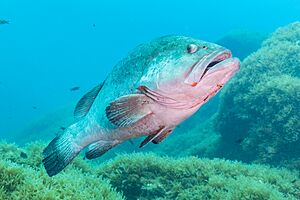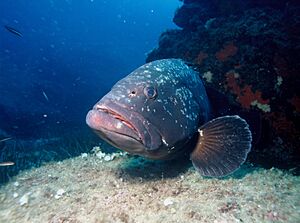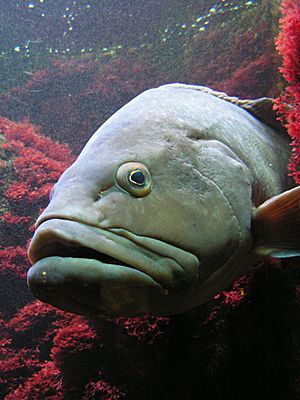Epinephelus marginatus facts for kids
Quick facts for kids Epinephelus marginatus |
|
|---|---|
 |
|
| Conservation status | |
| Scientific classification | |
| Synonyms | |
|
The Dusky Grouper, also known as the yellowbelly rock cod or yellowbelly grouper, is a large marine fish. Its scientific name is Epinephelus marginatus. This fish belongs to the grouper family. It is one of the most famous grouper species found in the Mediterranean Sea and along the coast of North Africa.
Contents
About the Dusky Grouper
The Dusky Grouper is a very big fish. It has an oval body and a large head. Its mouth is wide, and its lower jaw sticks out a bit.
What Does It Look Like?
This fish is usually dark reddish-brown or grey on its head and upper body. Its belly often has a yellowish-gold color. You can see irregular pale greenish-yellow or silvery-grey blotches on its body and head.
Its fins are mostly dark brown. The edges of its anal and tail fins often have thin white bands. The pelvic fins are black at their tips. The pectoral fins are dark reddish-brown or grey. Sometimes, the spiny part of its dorsal fin and the base of its pectoral fins are golden yellow.
The Dusky Grouper can grow up to 150 centimeters (about 5 feet) long. However, it is more commonly around 90 centimeters (about 3 feet) long.
Where Dusky Groupers Live
Dusky Groupers live in two main areas far apart from each other.
Atlantic and Indian Oceans
The first main area is in the eastern Atlantic Ocean. They are found from the west coast of Spain and Portugal, south along the coast of Africa. Their range extends into the southwestern Indian Ocean, reaching as far as southern Mozambique. They are also found all over the Mediterranean Sea.
South America
The second group of Dusky Groupers lives in the southwestern Atlantic. This is off the coast of South America, near southern Brazil, Uruguay, and northern Argentina.
Sometimes, they are seen further north than Portugal. There have been rare sightings in the Bay of Biscay and even in the English Channel. This includes areas as far north as northern France, Great Britain, and Ireland.
Dusky Grouper Homes
Dusky Groupers usually live near rocky reefs. You can find them from the surface down to depths of 300 meters (about 980 feet). They often hang out near beds of Posidonia seagrass.
Younger groupers, called juveniles, usually live closer to shore. They can even be found in rock pools. In protected areas, like marine reserves, both young and adult groupers live in shallower waters. However, young groupers always prefer shallower depths than the older ones.
Dusky Grouper Life
Adult Dusky Groupers usually live alone. They like to have their own territory. They prefer areas with rocky bottoms. Both young and adult groupers can also live in brackish waters, like estuaries, where fresh and salt water mix.
What They Eat
Their main food includes molluscs (like clams and snails), crustaceans (like crabs), and octopuses. As they get bigger, other fish become a more important part of their diet. They especially like to eat reef fish.
Reproduction and Life Cycle
Dusky Groupers are special because they are protogynous hermaphrodites. This means that all of them start their adult lives as females. As they get older and bigger, they change into males.
They become able to breed quite late in life. Females start breeding when they are about five years old. Then, between the ages of 9 and 16, they change into males. Most often, this change happens around age 12.
The fish start changing into males when they are about 65 centimeters long. However, most change sex when they are between 80 and 90 centimeters long. In some places, very large female fish are found. This suggests that not all females change into males.
During the breeding season, small groups of a few dozen groupers gather together. This is unusual because they usually live alone. These gatherings happen at special places where they lay their eggs.
Known breeding spots include the Medes Islands Marine Reserve in Spain. Other spots are off Lampedusa in Italy and Port-Cros National Park in France. All these places are in the Mediterranean Sea. In Brazil, fishermen think there are also breeding groups off the coast of Santa Catarina.
In the Mediterranean, breeding happens from June to September. During this time, one male will mate with several females. Breeding groups usually have about seven females for every male. Off Brazil, Dusky Groupers reproduce in early summer, between November and December.
When breeding, the biggest males claim and protect their territories. They will chase away other males and smaller females. These fish are known to live for a very long time, sometimes up to 50 years!
Fishing for Dusky Groupers
The Dusky Grouper is a popular fish to eat. Commercial fishermen catch them across their range. Large adult fish are also hunted by spear-fishing enthusiasts as trophies. They are also easily caught by people who fish with rods and lines, called anglers.
This fish grows slowly and has a unique way of reproducing. This makes it easy for too many to be caught. For example, if spear fishers target large males, it can upset the balance of males and females. This can affect how many baby fish are born. Some people in Italy have tried to raise and breed these fish in aquaculture farms.
In some countries, the Dusky Grouper is considered a special meal. In Spain, they have a saying: 'De la mar el mero y de la tierra el carnero'. This means 'From the sea the dusky grouper, and from the land the lamb'. It shows how much people like to eat this fish.
Protecting the Dusky Grouper
The number of Dusky Groupers caught dropped by 88% in seven countries between 1990 and 2001. These countries are a big part of where the fish live. In other areas, like West Africa, where many of these fish are caught, there isn't much information about their numbers.
Because of this, the International Union for Conservation of Nature (IUCN) has listed the Dusky Grouper as Vulnerable. This means they suspect the population has dropped by more than 50% over the last three generations. And the reasons for this decline are still happening.
To help protect them, France banned spearfishing for Dusky Groupers for ten years. South Africa has also set limits on how many can be caught. Many Marine Protected Areas have been created to protect the places where Dusky Groupers live. In Turkey, experts have suggested creating "no-take zones" along the Aegean and Mediterranean Sea coasts. They also recommend a total fishing ban for at least 3 to 5 years.
Images for kids





